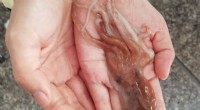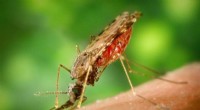
Wetenschap
LA heeft 90.000 bomen nodig om extreme hitte te bestrijden. Zullen bewoners opstaan om ze te planten?

Tegoed:CC0 Publiek Domein
In 2019 onthulde burgemeester Eric Garcetti een ambitieus plan om tegen 2021 90.000 bomen in Los Angeles te planten als onderdeel van LA's Green New Deal.
Om dit te bereiken, benoemde hij Rachel Malarich, de eerste boswachter van de stad, als hoofd van de afdeling Stedelijke Bosbouw, en gaf hij toestemming aan een netwerk van non-profitorganisaties en 'gemeenschapsambassadeurs' om bewoners te helpen en aan te moedigen bij het planten van hoognodige bomen.
Maar meer dan een jaar na Garcetti's deadline blijkt dat het planten van bomen in Los Angeles een stuk moeilijker is dan het klinkt, vooral als het gaat om die buurten die het meest behoefte hebben aan boombedekking.
Met iets meer dan 65.000 bomen die tot nu toe zijn geplant, merken ambtenaren dat hun afhankelijkheid van stadsbewoners voor het planten en verzorgen van de bomen aanzienlijke beperkingen met zich meebrengt:bewoners in armere buurten die geen land bezitten, kunnen het moeilijk vinden om daadwerkelijk bomen te planten, of ze ondervinden problemen bij het verzorgen van een nieuwe boom tijdens hun kritieke driejarige vestigingsfase.
In sommige gebieden, zoals de kale bomen in het centrum, worden nieuwe bomen vaak vernietigd door voertuigen of vandalen voordat ze volwassen kunnen worden, terwijl oudere bomen worden gekapt door ontwikkelaars van nieuwe gebouwen of transportploegen die zichtlijnen op kruispunten willen vrijmaken.
Maar dit is niet de eerste keer dat L.A. een grootschalige aanplant van bomen heeft gelanceerd en echter tegen hindernissen aanloopt. In 2006 lanceerde de burgemeester van Los Angeles, Antonio Villaraigosa, een programma om 1 miljoen bomen te planten, samen met New York City en Shanghai. Maar in april 2013 had de stad er iets meer dan 400.000 geplant.
Deze keer zei Malarich dat ze zich meer zorgen maakt over het gelijkheidsaspect van bomen en waar ze worden geplant dan om het aantal. Ze merkt ook op dat Garcetti's belofte een belofte inhield om de boomkruinen van steden tegen 2028 met minstens 50% te versterken in gebieden met lage inkomens.
"De hoeveelheid bescherming die we bieden door middel van een groter bladerdek is belangrijker dan het aantal bomen," zei Malarich.
Bomen bieden Angelenos talloze voordelen, waaronder het opvangen van afstromend regenwater en het aanvullen van grondwater, het zuiveren van de lucht en het verbeteren van de geestelijke gezondheid. Onderzoekers hebben ook ontdekt dat buurten met weinig bomen en veel bestrating, grote gebouwen en andere warmteabsorberende oppervlakken 10 graden warmer kunnen zijn dan omliggende gebieden.
Zelfs met historische droogtebeperkingen hebben experts het belang benadrukt om bomen water te geven en in leven te houden. Tijdens de laatste droogte zijn mogelijk maar liefst 14.000 bomen in L.A.-parken - ongeveer 4% van het totaal - gestorven.
The drought restrictions implemented June 1 by the L.A. Department of Water and Power includes an exception for the hand-watering of trees, however, and should not have an adverse effect on tree health if they are followed correctly, experts said.
As priorities have changed, so have names—Million Trees LA is now called City Plants, a reflection of the emphasis on low canopy areas and maximizing the benefits of trees rather than reaching a specific number. City Plants runs a public-private partnership between the city and six nonprofits to coordinate tree planting and care throughout L.A.
But to get more trees in the ground, it's imperative to have community buy-in—the city itself doesn't do much planting directly. An estimated 90% of L.A.'s urban forest is on private property, and even street trees are often under the care of the residents who live nearby.
City Plants will give seven free trees to any L.A. resident to plant in their yard, thanks to funding from the Department of Water and Power. The trees are delivered to homes, along with stakes, ties and fertilizer pellets. City Plants tracks planting locations and monitors the trees' survival for three years—the most vulnerable period of a young tree's life.
Residents can also request a street tree—one planted in the public right of way—but must sign a Commitment to Water form promising to care for the tree for the first three to five years of its life, which means a deep watering of 10-15 gallons of water once a week by hose or bucket. After the three-year mark, the trees become the responsibility of the Urban Forestry Division.
In some cases, money from City Plants and state grants from the California Department of Forestry and Fire Protection are able to fund the establishment care for the tree—which includes watering, adjusting stakes and ties and anything else needed to ensure survival in the first three years.
The next step, however, is to make sure the communities that need trees have access to them.
The Tree Ambassador program was created last year to develop leaders in historically disadvantaged neighborhoods and assist them in planting and caring for trees in their communities. The inaugural cohort began in September 2021 and ended this April with about 400 trees planted.
The ambassadors serve as community liaisons to help find residents who are interested in planting trees and communicate the importance of caring for neighborhood trees.
"The way we structured that program is really to amplify local leader voices," said City Plants executive director Rachel O'Leary. "And many of those local leaders living in neighborhoods that were historically disinvested—wanting to really, honestly, directly compensate them for their community organizing."
It's a model that not everyone agrees with.
"They're leaning on nonprofits to get there, they're leaning on homeowners to get to that goal (of 90,000 trees)," said Katherine McNenny, co-founder of Industrial District Green, a nonprofit focused on tree planting downtown. "That's cheating."
Giving out trees benefits homeowners who live in areas that might not need more trees, rather than a renter in a low-canopy area, especially with the three-year watering commitment, McNenny said.
"Someone in a low-income community who got a free tree from the city of L.A. a block away … how are they gonna water those trees?" McNenny said.
Though McNenny appreciates the work done by nonprofits, she believes the city itself needs to doing more direct planting and watering by city employees.
On a recent sunny Saturday morning that quickly rose to sweltering temperatures, tree ambassador Cristina Velazquez sat at a green table in Koreatown next to buckets of tree saplings.
Curious locals stopped by to ask—are you really giving away trees for free? How can I get one?
Though most of the trees were reserved for pickup, some were available for same-day adoption—coast live oaks, Canary Island pines, a crape myrtle with showy summer flowers. Velazquez warned some people to carefully consider how much room they had in their yards, because the oaks would get large.
"It is a new member of your family," Cristina Basurto, senior community engagement coordinator for the Koreatown Youth and Community Center, told people who came to take their trees home. "When you talk to them, they thrive even more."
Many people were first-time tree planters and keen on making sure their trees survived. Mulch is good, Basurto advised, but she warned folks against making "mulch volcanoes" around the base of the tree because they can foster too much moisture and cause bark rot. Pomegranates are multi-trunk trees and do particularly well with other pomegranates nearby. And guavas, well you'll have to fight with the squirrels and birds for them.
Some of the people who came to pick up trees were homeowners, though a few were renters who obtained permission from their landlords or lived in a building with a dedicated gardener.
City Plants has been holding various tree adoption events around the city, partnering with organizations like the KYCC, Los Angeles Conservation Corps and Tree People.
"A lot of the open space we have available isn't in the sidewalks; it is in their homes," Basurto said.
But working with disadvantaged communities also means meeting their immediate needs first. When KYCC goes out and offers trees in the communities it's serving, the biggest problem is often litter, which is how Velazquez got involved with the Tree Ambassador program.
When the 24-year-old from Westlake moved home after finishing college in 2020, she noticed that her neighborhood was in bad condition "in terms of public hygiene."
She started a weekly street cleanup group and learned of KYCC, which was planting trees in Westlake and also doing street cleanings. Velazquez said her cleanup group would gather one to two trucks full of litter every week.
"The next step is the tree," Basurto said.
While there's always talk of funding for the trees themselves, what's often neglected is money for establishment care, which is why community buy-in is so important, Malarich said.
One of the partners for the Tree Ambassador program is long-established environmental advocacy group Tree People, which has its own 30-year-old Community Forester Program. Its model also focuses on empowering volunteers to lead tree-planting events in their own communities.
Tree People currently has a grant to plant 1,000 trees exclusively in the Watts neighborhood and distribute thousands more trees for schools and yards, said Ariel Lew Ai Le Whitson, director of education and community. It's applying for another grant to plant 4,000 trees in South L.A.
Not everyone is always excited about getting a tree planted in their neighborhood, however. When walking on the sidewalks of L.A., it's easy to see some of the infrastructure damage caused by trees.
"A resident might have some feelings because a tree was planted there many years ago and maybe messed up their sidewalk," said Eileen Garcia, senior manager of community forestry.
As tree planting efforts continue, City Plants emphasizes its philosophy of "right tree, right place, right reason" to ensure trees aren't causing further damage in the communities they're placed in, executive director O'Leary said.
This issue is exacerbated in historically disadvantaged low canopy areas, where you often see parkways that are too narrow for trees, or trees growing in the public right of way.
Garcia said she hopes to see more funding for more drastic actions such as tearing up large stretches of concrete to create new locations for trees.
The city is currently undergoing a massive tree inventory of street trees and vacant spots, covering 500 square miles, Malarich said. An arborist will visit every tree in the public right of way and record the species, age and size of the tree. Officials hope to complete the study by next summer, and estimate they will count more than 700,000 trees.
Malarich is also overseeing an update of the recommended street tree species list, which has to take into account infrastructure and spacing, climate, and the wide range of soil types that can be found around the city.
But it all comes back to what's important to the community.
"That's part of what's so complex—we have our expert opinion based on science and data related to tree species but we also have a living piece of infrastructure that people have a strong opinion about," Malarich said.
 Bepalen wat bindt aan slijm
Bepalen wat bindt aan slijm Chemicaliën kunnen hun identiteit veranderen, dankzij de vloeistoffen waar ze zich bevinden
Chemicaliën kunnen hun identiteit veranderen, dankzij de vloeistoffen waar ze zich bevinden Techniek om functionele materialen te maken op basis van polymeren van metaalclusters
Techniek om functionele materialen te maken op basis van polymeren van metaalclusters Een manier om de structurele stabiliteit in gespannen halide perovskieten te vergroten
Een manier om de structurele stabiliteit in gespannen halide perovskieten te vergroten Natuurkundig team onderzoekt invloed van ionen op atomaire bewegingen
Natuurkundig team onderzoekt invloed van ionen op atomaire bewegingen
 Where Do Squirrels Sleep?
Where Do Squirrels Sleep?  CO2-uitstoot veroorzaakt verloren arbeidsproductiviteit, uit onderzoek blijkt
CO2-uitstoot veroorzaakt verloren arbeidsproductiviteit, uit onderzoek blijkt Cyanobacteriën leven 600 meter onder de grond zonder zonlicht
Cyanobacteriën leven 600 meter onder de grond zonder zonlicht Studie:Oceaanviskweek in tropen en subtropen die het meest worden getroffen door klimaatverandering
Studie:Oceaanviskweek in tropen en subtropen die het meest worden getroffen door klimaatverandering Snelle verandering in koraalriffen roept wereldwijd op tot heroverweging
Snelle verandering in koraalriffen roept wereldwijd op tot heroverweging
Hoofdlijnen
- Zeldzame vliegende vossen neergeschoten bij gruwelijke aanval in Australië
- Wat gebeurt er als je een lijk ontdooit?
- Een driedimensionaal model van een plantencel maken met labels
- Wat zijn concentratiegradiënten in de microbiologie?
- Op AI gebaseerde screeningmethode zou de snelheid van nieuwe geneesmiddelenontdekking kunnen verhogen
- Ondanks bosverlies, een beschermd Afrikaans gebied heeft nog steeds potentieel om tienduizenden olifanten te ondersteunen, 1K leeuwen
- Hoe overtuigend is een Y-chromosoomprofielmatch tussen verdachte en plaats delict?
- Getoonde chimpansees die spontaan om de beurt een cijferpuzzel oplossen
- Verdrietig en verontrustend:enorme aantallen vogeldoden in Australische hittegolven onthullen dat er een groot verlies op komst is
 Bosbrand Portugal smeult als eerste slachtoffers begraven
Bosbrand Portugal smeult als eerste slachtoffers begraven Zon in een doos zou hernieuwbare energie opslaan voor het net
Zon in een doos zou hernieuwbare energie opslaan voor het net Kunstmatige intelligentiesysteem maakt gebruik van transparante, menselijke redenering om problemen op te lossen
Kunstmatige intelligentiesysteem maakt gebruik van transparante, menselijke redenering om problemen op te lossen Studie:VS neemt lage weg naar groei met nadelige gevolgen voor welzijn, toekomstige welvaart
Studie:VS neemt lage weg naar groei met nadelige gevolgen voor welzijn, toekomstige welvaart Herkomst:hoe de oorsprong van een object authentieke, inclusief verhalen vertellen
Herkomst:hoe de oorsprong van een object authentieke, inclusief verhalen vertellen Schilderij uit Haystacks-serie vestigt veilingrecord voor Monet
Schilderij uit Haystacks-serie vestigt veilingrecord voor Monet Wetenschappers ontwikkelen nieuwe aanpak om belangrijke onontdekte functies van eiwitten te identificeren
Wetenschappers ontwikkelen nieuwe aanpak om belangrijke onontdekte functies van eiwitten te identificeren Wereldwijde zand- en grindwinning conflicteert met de helft van de duurzame ontwikkelingsdoelen van de VN
Wereldwijde zand- en grindwinning conflicteert met de helft van de duurzame ontwikkelingsdoelen van de VN
- Elektronica
- Biologie
- Zonsverduistering
- Wiskunde
- French | Italian | Spanish | Portuguese | Swedish | German | Dutch | Danish | Norway |

-
Wetenschap © https://nl.scienceaq.com






